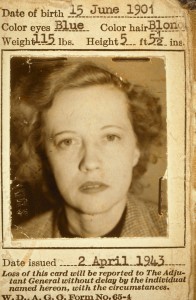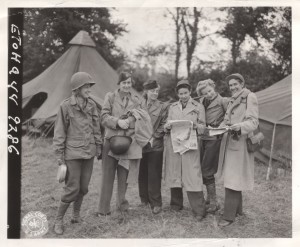Volume 34, No. 4
Fall 2017 Issue
Candi Carter Olson is the author of “’This was no Place for a Woman’: Gender Judo, Gender Stereotypes, and World War II Correspondent Ruth Cowan.” In an interview with Editorial Assistant Virginia Harrison, she discussed how he became interested in the subject, why Cowan challenged gender stereotypes, and how Cowan’s work was legitimized.
How did you become interested in Ruth Cowan’s work?

I was doing a Women’s History Month keynote address, and I wanted to include a woman from Utah with the rest of the women reporters I was discussing. My own research focuses on the history of newswomen, in particular women’s press clubs. Through that research I’ve encountered a great many women battling the idea that they have to fully conform to the stereotypical ideas of womanhood of a time, while they also have to be fully transgressive in their own work.
Cowan’s story struck me in how magnified this battle was in both her professional and personal lives. She battled misogyny as a reporter, even though she was highly successful, and she also spent a great deal of time reporting on the conflicts faced by the women with whom she was embedded during the war. This last point intrigued me and that’s why I wrote this particular article.
Why is the theory of “gender judo” useful in understanding Cowan’s war reporting?
Every so often there’s a theory that comes along that makes light bulbs explode in your head, and this is one of those theories for me. As noted, I research many women who walk a fine line between being an “acceptable” woman so that they can continue to do work that obviously violates those gendered ideologies. Gender judo describes the ways that individual women today are using gender stereotypes to their advantage. In essence, the women perform to those stereotypes in some ways so that they are rendered seemingly harmless to the establishment. They are then allowed to be progress through the ranks because they aren’t seen as a threat.
This performative femininity was huge for women reporters and editors in the nineteenth and twentieth centuries, and Cowan’s reportage shows it clearly. She would write an article that outlined women nurses or WAAC’s feminine characteristics, like their love of silly hats and finger nail polish, and then throw in a transgressive behavior, like throwing 6-foot-tall men over their shoulders or taking aim with a sniper’s gun. The first disarms the audience. Then the second image comes along and adds a new layer definition to the audience’s idea of a “woman.” It’s nuanced and interesting to study as a rhetorical technique, not just a performative role.
Why do you think Cowan chose to challenge gender stereotypes through her writing about the war instead of through another avenue?
Cowan challenged gender stereotypes just by doing her job. Again, her existence as a war correspondent forced her to perform gender judo in her own life. Men tried to send her home when she landed in Algiers. They refused her access to everything from the front lines to even a telegraph operator to wire her stories home. She had to be creative and performative to get her work done. The job was stressful and frustrating, and it was made even more stressful and frustrating by gender inequality.

You discuss the fact that editors from the Associated Press and other news organizations asked their male reporters to mimic Cowan’s writing style and produce more “colorful pieces” about the war. How do you think she would have responded to these comments legitimizing her work as a female war correspondent?
The Washington Press Club Foundation did an oral history with Ruth Cowan Nash in 1988, five years before she died. That oral history shows her as salty, funny, indomitable spirit. I don’t wish to put words into her mouth, but I honestly think she would have laughed. In a way, it’s obvious that Cowan’s reportage and that of her fellow women war correspondents was interesting to reading audience. Would you rather read a list of military acronyms and dry reports on troop positions, or would you rather read about the people who were affected by war every day? Most people would answer the latter.
How does Cowan’s work and her legacy contribute to today’s discussion of newsroom diversity?
When we are discussing newsroom diversity, we are discussing the ways that diversity behind the scenes contributes to richer reporting and coverage. Diverse reporting is writing with context and nuance. Cowan’s work shows this principle in action. If Cowan and her fellow women war correspondents hadn’t told the stories of the people, if they hadn’t dug deeper to find the personal angle, then our understanding of the real effects of World War II would be much thinner. They were forced to find sources who were not the government talking heads. This meant that the women’s stories gave audiences stories they weren’t reading anywhere else.
What are some of the best sources to learn more about Cowan and other female war correspondents?
There are so many great resources out there on the women war correspondents of World War II. You can find a transcript of Cowan’s oral history interview with the Washington Press Club Foundation here: http://wpcf.org/ruth-cowan-nash/. And the date-stamped video can be found on C-SPAN: https://www.c-span.org/video/?299444-1/ruth-cowan-nash-oral-history-interview. In 2011, Hurry Up Sister released its award-winning documentary, “No Job for a Woman.” The website that accompanies this documentary has clips and articles written by scholars to add context to the lives recounted in the documentary: http://nojobforawoman.com/.
Linda Lumsden explored Cowan’s rejection of the “woman’s angle” in her article, “The Essentialist Angle of the ‘Woman’s Angle’ in Cold War Washington: The Case of Associated Press Reporter Ruth Cowan.” This is a particularly pertinent exploration for people studying diversity and gendering in reportage. Carolyn M. Edy recently published, The Woman War Correspondent, the U.S. Military, and the Press: 1846–1947, which is useful for examining the broader context of the women war correspondent in America. World War II was the first time that women were able to get official military press credentials, but it was not the first time that women reporters were working to bring war stories home to their readers.
Nancy Caldwell Sorel’s The Women Who Wrote the War: The Riveting Saga of World War II’s Daredevil Women Correspondents is a brightly written and fascinating account of women war correspondents’ struggles and victories. Lilya Wagner’s Women War Correspondents of World War II covers the women’s daily lives through in-depth interviews with the women themselves.
